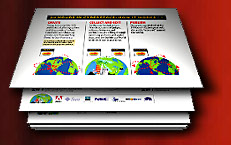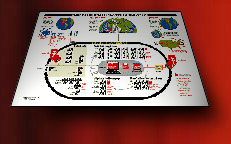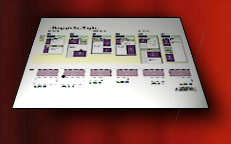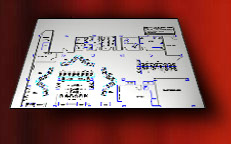

|
|
 |
|
24 Hours in Cyberspace began by dispatching over 150 of the world's best photojournalists around the world on February 8, 1996 to document the human stories behind the digital revolution. They were also joined by thousands of students and amateurs who submitted their own stories.
On the front-end of the technology process was Eastman Kodak, whose digital cameras and professional film captured the majority of the project's images. Professional photographers with digital cameras downloaded their images directly into an NEC Versa notebook computer, where they used Adobe Photoshop, the leading digital image editing software, to prepare their photos for transmission. They also used a unique Photoshop "plug-in" from The Software Construction Company to enter captioning information. Once they were ready, their NEC notebooks dialed directly into 24 Hours in Cyberspace, using the state-of-the-art TeleFinder BBS product from Spider Island Software, where their calls were answered automatically by US Robotics modems attached to a Power Computing BBS server. Professional photographers using film scanned their images, in some cases using sites equipped with a Kodak Digital Science Photo CD Imaging Workstation and in others using a Polaroid SprintScan scanner. Once the images were digitized, they used Adobe Photoshop software and the plug-in from The Software Construction Company to prepare the photos and enter captions. Technicians at these locations then either dialed directly into Mission Control or used the Internet to transfer the files. Meanwhile, groups of students participating in a parallel "Student Underground" version of the project crafted their own stories about Cyberspace. Early registrants used Kodak Digital Science DC40 cameras to shoot their photos, and then used a complete set of Adobe Internet publishing tools, including Adobe Photoshop, Adobe PageMill, Adobe Acrobat, and Adobe Illustrator software, to create their own Web pages. When they were done, they sent their pages over the Internet into Mission Control for judging. Complementing these images were audio clips based on extensive telephone de-briefings of the professional photographers, as well as interviews of celebrity visitors to Mission Control. This material was edited, mixed, and restored using Sonic Solution's leading-edge digital audio workstations networked with Sonic's MediaNet network and running on high-end MacOS workstations from Power Computing. The clips were encoded using Real Audio technology from Progressive Networks. These images, stories and audio clips were transmitted to Mission Control, a specially constructed 6,000-square-foot facility in San Francisco's South of Market area. There, a team of more than 80 editors, programmers, and designers built the Web site on the same day. They worked on the largest, most powerful one-day Internet network ever, integrated and managed by Sun Microsystems. Editors worked on more than 60 Sun SPARC and UltraSPARC Workstations, 25 NEC PowerMate Series systems with NEC MultiSync monitors and several Power Computing Systems. All of these systems were connected to a 100 Base-T network, which ran ten times faster than a normal office LAN. The network also included a huge database server which ran on two Sun SPARC 1000 servers with Sun RAID disk arrays, as well as separate Sun Netra servers for email, ftp and Web publishing. Collectively these machines had more than 11,000 MB of RAM storage and almost 300 Gigabytes of disk storage. Meanwhile Sun's Firewall-1 security software was running silently in the background, on patrol for hackers. Best Power's uninterrupted power supply products protected against brownouts and blackouts. Two complementary teams of professional journalists, designers and programmers harnessed the horsepower of this network to build the site in one day. First, a team of judges checked the quality of the transmissions, shifted through the incoming stories, assigned them to themes, and rated each submission. They used a sophisticated software application developed by Illustra Information Technologies and displayed through Netscape Navigator 2.0 software. The Illustra software automatically rejected invalid entries and sent confirming thank-you notes to the rest. Each story was stored in a central Illustra multimedia database, which managed the growing mountain of photographs, graphics, text, audio, and video throughout the day. The judges worked on Sun SPARC and UltraSPARC workstations. Next, a team of editors and designers, on loan from the world's top newspapers and magazines, and working on Sun UltraSPARC Workstations, NEC PowerMate Systems and NEC MultiSync Monitors, used a series of Illustra-developed forms and Netscape Navigator 2.0 software to select and edit photos, text, and graphics for each story. The editors also used Adobe Photoshop software, customized with project-specific image editing tools, to crop, enhance, and compress the photos. Once the raw content was prepared, a new tool developed by NetObjects, Inc., created the Web pages and built the entire Web site. The NetObjects publishing tool retrieved the edited images and text stored in the Illustra database, and laid out the stories using templates designed by Clement Mok designs, one of the world's top Web site design firms. The tool and the templates allowed editors to use a copy-and-paste approach to build pages and toggle quickly between different story designs. Once they selected a story design, the tool automatically generated all the HTML code, the links for each page, and updated all of the site's story listings and indices. The NetObjects tool automatically kept track of all pages, letting editors republish the Web site with new stories and updated story listings every half hour. The stories were then staged on a powerful Sun Netra server running Netscape Communications Server software. Proofers and testers, using Netscape Navigator 2.0, tested all the links and checked each page. Every 30 minutes, the NetObjects tool swept through and collected all the pages that were ready for publishing. MFS Communications provided voice and data communications support for the event. Once the Web site was ready to be published, MFS transmitted the project photos and stories over its high-speed Asynchronous Transfer Mode (ATM) network to MAE East and MAE West, two very large Internet interconnection points operated by MFS. InternetMCI, the Internet communications powerhouse, handled peering for the project at both locations. Cisco Systems provides a router at Mission Control. In addition to this high-speed Internet connectivity, MFS provided local and long distance phone service to keep Mission Control in touch with the professional photographers around the world who are working on this project. As Internet users visited the site, they avoided getting caught in online gridlock thanks to innovative "mirroring" arrangements with the Internet 1996 World Exposition, Internet MCI, BBN Planet and Sun Microsytems. Instead of providing access to the Web site through a single phone line connected to a single machine, the site was instead replicated automatically to the Exposition's five "Central Park" servers located around the world. These servers, connected by very high speed 45 Mbps dedicated pipelines, effectively tripled the international capacity of the Internet on that day. In addition, the site was mirrored in a total of 15 Sun Netra servers located at Internet MCI in Atlanta, BBN Planet in College Park, Maryland and Sun Microsystems in Mountain View, California. Because these sites functioned on a "round robin" basis, visitors who typed in the single address, "http://www.cyber24.com" were automatically routed to Georgia, Maryland or California. To view these documents on a Mac, open the CD and find the "How It Was Done" folder. Under Windows 3.1 or Windows 95, open the "PDF" folder. Double-click the corresponding files listed below. |
 |
We've put together a six-page PDF that explains how we collected, edited and published the stories that make up the project in 24 hours.
|
 |
Open this one-page PDF to see an overview of the whole project. It explains how all the pieces came together on February 8th, 1996, to produce 24 Hours in Cyberspace.
|

|
In order to build web pages for all of our stories in one day, we developed over thirty HTML-coded page templates. This PDF is a one-page excerpt from our template style guide.
|

|
If you're curious about Mission Control and how we fit more than $2.5 million worth of equipment and about 80 people per shift into 6,000 square feet, open this PDF of Mission Control's floorplan. It shows how it was organized and what equipment was used.
|
|
© 24 Hours in Cyberspace. All Rights Reserved. |